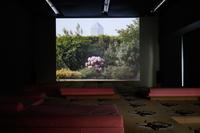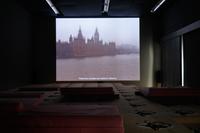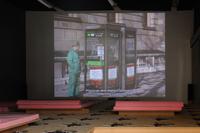Patrick Keiller: London – Robinson in Space – Robinson in Ruins
Three film essays on history, politics, landscape, memory and time. Screenings daily in the cinema.
Patrick Keiller’s film trilogy has been included at the very beginning of the project Oh and Hah, Beauty, Ruin and Slack – in its first scene, Metamorphosis, observing what happens to places as turbulent, cycled or sometimes lengthy times of change pass through them. We imagine that similar films could have been made about Ostrava, but were not. The film trilogy is an intoxicating mixture of documentary observation, philosophical reasoning and quasi-narrative story. In the form of a voice-over, a narrator describes the journey of a fictional character, a flâneur named Robinson. Keiller presents his thoughts in the form of travelogues (in the manner of the writer W. G. Sebald). He creates comprehensive, provocative and disturbing essays on history, politics, landscape, memory and time.
The films London (1994) and Robinson in Space (1997) are the narrations of an unnamed character speaking with the voice of the actor Paul Scofield. The character accompanies his friend and former lover, the invisible Robinson, on a series of trips around London. Robinson explores London and its problematic past and present, artificial preservation of traditions, the Irish War, colonialism, militarism, poor food, sexual restrictions, monarchism… Robinson in Space travels beyond London’s borders and combines the topographic-critical method with visual natural and agricultural sceneries of England. Both films are considered to be a critique of the United Kingdom’s economic setting under the Conservative regime in 1979–97, seen in broad historical, cultural, economic, political and philosophical contexts. The film vocabulary does not seem hybrid at first glance, yet it conceals the approaches of documentary film, drama (through film music, having the function of a time machine), fiction, film with strong educational, historical, visual, and diary aspects.
At the beginning of the film London, a cruise ship passing under Tower Bridge introduces you to the Sherlockian atmosphere of the investigative story of Robinson and the narrator’s character. The cruise ship represents a combination of contemporary tourism with colonialism and migration. The film is a visual search proving that civilizational and social movements are not hidden, but taking place right before our eyes. The joint search initiated by Robinson as a detective plot is based on a long observation of landscape, explaining “the molecular basis of historical events that allow us to catch a glimpse of the future”. Robinson is convinced that London is the first metropolis that has disappeared, since civic life has disappeared in it. Robinson convicts central London of decline and seeks modernity in the suburbs.
Robinson in Space, in which “space” stands for the universe as well as England, believes in the transformative potential of landscape. Long observation of landscape and viewing it will cause changes in society, changes in the fields of nuclear energy, militarism, extensive agriculture, fossil fuel extraction, economics, ecology. The film intertwines the different pace of time in the economy and in nature. The Sherlock Holmes atmosphere is replaced by James Bond.
Robinson in Ruins (2010), narrated by Vanessa Redgrave, is a peripatetic study of London 16 years after their first investigation. In his new search, Robinson, released from prison, is connected to a network of non-human intelligence wishing to preserve life on Earth. We are taken into the neoliberal ruins of a society based on information flows, transportation, technology, coal, oil, the nuclear and the automotive industries. Its pictures alternate with those of non-human life forms, plants, lichens, animals.
Edith Jeřábková
Patrick Keiller is a prominent British filmmaker, writer and lecturer dealing with the changing image of the United Kingdom, mainly in three epic film essays London, Robinson in Space and Robinson in Ruins. His major projects include The City of the Future (2002–05), an exploration of urban space as it appears in moving pictures held in the BFI’s National Film Archive. Within the Arts and Humanities Research Council, he realised the project The Future of Landscape and the Moving Image (2007–11), an exploration of ideas about the landscape, the environment, dwelling and displacement. The project included the production of the feature-length film Robinson in Ruins (2010), first exhibited at that year’s Venice Film Festival, and later the basis for The Robinson Institute, an exhibition at Tate Britain in 2012 accompanied by a book The Possibility of Life’s Survival on the Planet. In 2013, Verso publishers published an essay collection, The View from the Train. In 1986, Keiller undertook a British Council Academic Exchange visit to Czechoslovakia to research the Czechoslovak avant-garde of the 1920s and 1930s. He was a visiting research fellow at the Open University (2011–14) and was the Sir Arthur Marshall Visiting Professor of Urban Design at the University of Cambridge (2017–18).
←→
Special thanks to the Ministry of Culture of the Czech Republic and Moravian-Silesian Region.



